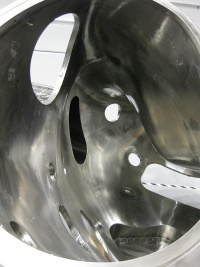Stellarator: Difference between revisions
Jump to navigation
Jump to search
No edit summary |
No edit summary |
||
| Line 1: | Line 1: | ||
A stellarator is a magnetic confinement device. The rotational transform is predominantly generated by external coils - differently to tokamaks for which the poloidal field is generated by plasma currents. Hybrid concepts employ both external coils and self-generated ([[Bootstrap current|bootstrap]]) currents (e.g. NCSX). | A stellarator is a magnetic confinement device. The [[Magnetic shear|rotational transform]] is predominantly generated by external coils - differently to tokamaks for which the poloidal field is generated by plasma currents. Hybrid concepts employ both external coils and self-generated ([[Bootstrap current|bootstrap]]) currents (e.g. NCSX). | ||
[[File:NCSX_plasmaVessel.jpg|200px|thumb|right|NCSX plasma vessel.]] | [[File:NCSX_plasmaVessel.jpg|200px|thumb|right|NCSX plasma vessel.]] | ||
Revision as of 09:26, 23 October 2009
A stellarator is a magnetic confinement device. The rotational transform is predominantly generated by external coils - differently to tokamaks for which the poloidal field is generated by plasma currents. Hybrid concepts employ both external coils and self-generated (bootstrap) currents (e.g. NCSX).
Defunct stellarators
- ATF (USA)
- W7-AS (Germany, 1988-2002)
- CHS (Japan)
- NCSX (USA, cancelled before construction was completed)
Operational stellarators
- LHD (Japan)
- TJ-II (Spain)
- HSX (USA)
- H-1NF (Australia)
- TJ-K (Germany) - formerly TJ-IU
- WEGA (Germany)
- CAT/CTH (Auburn, USA)
- UST-1 (Spain, tabletop)
